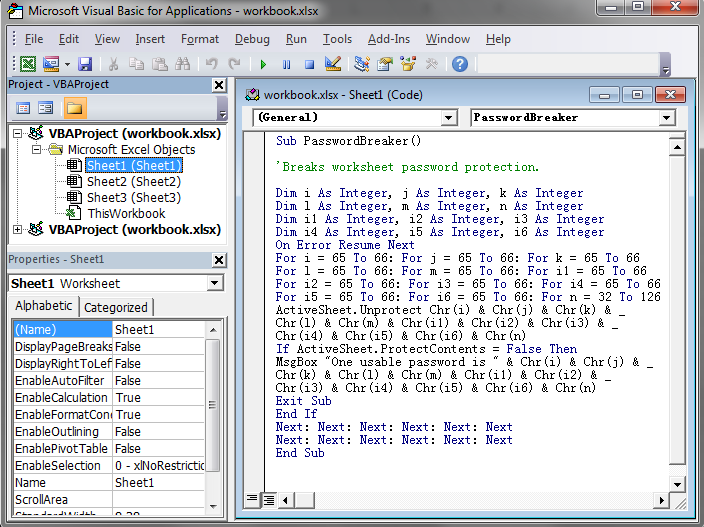3 Simple Ways to Unprotect Excel 2010 Sheets

How to Unprotect Excel 2010 Sheets

If you're working with Microsoft Excel 2010 and need to unprotect a workbook or sheet to make changes or perform analysis, you might find yourself stuck if you don't know the password or method. Fortunately, there are straightforward methods to unlock these sheets without going through the hassle of contacting the creator or trying complex software. Here are three simple ways to unprotect Excel 2010 sheets:
Method 1: Using the Password

If you have the password for the workbook or sheet, unprotecting Excel 2010 is straightforward:
- Open the Excel file.
- Click on the 'Review' tab in the ribbon.
- Select 'Unprotect Sheet' or 'Unprotect Workbook'.
- Enter the password when prompted.
- Once entered, the sheet or workbook will be unprotected, allowing you to make changes or view hidden data.
🔒 Note: Keep the password in a secure location for future reference, as you might need it again.
Method 2: VBA Macro to Bypass Password

Visual Basic for Applications (VBA) provides a powerful scripting language for automating Excel tasks, including bypassing password protection. Here's how to use a VBA macro to unprotect an Excel sheet:
- Open your workbook in Excel 2010.
- Press Alt + F11 to open the VBA Editor.
- In the VBA Editor, go to Insert > Module to create a new module.
- Paste the following VBA code into the module:
Sub UnprotectSheet()
Dim i As Integer, j As Integer, k As Integer
Dim l As Integer, m As Integer, n As Integer
Dim i1 As Integer, i2 As Integer, i3 As Integer
Dim i4 As Integer, i5 As Integer, i6 As Integer
On Error Resume Next
For i = 65 To 66: For j = 65 To 66: For k = 65 To 66
For l = 32 To 126
For m = 32 To 126
For i1 = 32 To 126
For i2 = 32 To 126
For i3 = 32 To 126
For i4 = 32 To 126
For i5 = 32 To 126
For i6 = 32 To 126
ActiveSheet.Unprotect Chr(i) & Chr(j) & Chr(k) & Chr(l) & Chr(m) & Chr(i1) & Chr(i2) & Chr(i3) & Chr(i4) & Chr(i5) & Chr(i6)
If ActiveSheet.ProtectContents = False Then
MsgBox "Password found"
Exit Sub
End If
Next: Next: Next: Next: Next: Next: Next: Next: Next: Next: Next
End Sub
Method 3: Use Online Services or Software

When the above methods fail or if you're not comfortable with VBA, there are online services and software tools designed specifically to unlock password-protected Excel files:
- Search for a reputable online service or software that offers Excel password recovery. Tools like Excel Password Recovery, LostMyPass, or PassFab for Excel are well-regarded for their capabilities.
- Upload or open your Excel file in the tool or website as per the instructions.
- Follow the process to recover or remove the password. This might take some time, especially for complex passwords.
- Once the password is recovered or removed, download your file and open it in Excel to verify that the protection has been removed.
⚠️ Note: Be cautious when using online services due to privacy concerns. Always check the legitimacy and security measures of the service before uploading sensitive information.
In this detailed exploration, we've covered three effective methods for unprotecting Excel 2010 sheets. These approaches cater to different scenarios and technical comfort levels, from simple password entry to more advanced VBA scripting or using specialized software. Understanding these methods can save you time and frustration when working with protected spreadsheets. Remember to protect your own sheets with strong passwords when needed, and store these passwords securely. By familiarizing yourself with these techniques, you'll be better equipped to handle Excel's protective features efficiently.
Is it legal to use these methods to unprotect Excel sheets?

+
Yes, it is legal to unprotect Excel sheets if you have the right or permission to do so. However, be aware that using these methods to access someone else’s data without their consent could be against the law or company policy. Always ensure you have the authority to remove password protection.
What should I do if the VBA macro doesn’t work?

+
If the VBA macro fails to find the password, it might be due to a more complex password or an older version of Excel where this method isn’t effective. In such cases, consider using specialized recovery software or contact the person who set the password if possible.
Can these methods be used on newer versions of Excel?

+
Yes, these methods are generally applicable to newer versions of Excel, but the VBA code might need slight modifications. For online services or software, compatibility should be checked with the specific tool’s documentation or support.